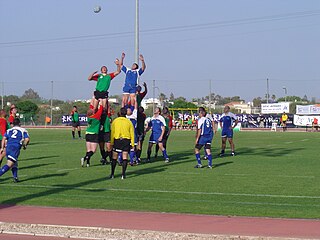
The Russia national rugby union team, nicknamed Medvedi, represented Russia in men's international rugby union international competitions. The team is administered by the Rugby Union of Russia (RUR). The RUR is considered the official successor union of the Soviet Union by World Rugby and the combined CIS team which played in the early 1990s. Since 1992, the team has played as Russia. Its first test match as Russia was against the Barbarians in Moscow in June 1992 and the country's first test against an official Test nation was against Belgium later that same year.

Rugby union in Russia is a moderately popular sport. Russia was in 2011 ranked 20th worldwide by the World Rugby, having over three hundred clubs and close to 22,000 players nationally. Russian Rugby Championship is the top-level professional competition held in Russia. Krasnoyarsk, in the middle of Siberia, is traditionally the heartland of Russian rugby.

Rugby union in Georgia is a popular team sport. Rugby union is considered one of the most popular sports in Georgia.

The Lithuania national rugby union team represents Lithuania in men's international rugby union competitions. Nicknamed The Knights (Vytis), is considered one of the relatively stronger tier 3 teams in European rugby and currently compete in the second division of the Rugby Europe International Championships in the Rugby Europe Trophy, a competition which is just below the Rugby Europe Championship where the top 6 countries in Europe compete. They are yet to participate in any Rugby World Cup and play in black with a pattern involving the colours red, yellow and green.

Rugby union in Armenia is a growing sport. The national team is currently unranked in the world rankings, which records only the top ninety-six countries. The governing body for Armenia is the Rugby Federation of Armenia, headquartered in Yerevan.

The three Baltic countries, or the Baltic states – Estonia, Latvia, and Lithuania – are held to have continued as independent states under international law while under Soviet occupation from 1940 to 1991, as well as during the German occupation in 1941–1944/1945. The prevailing opinion accepts the Baltic thesis that the Soviet occupation was illegal, and all actions of the Soviet Union related to the occupation are regarded as contrary to international law in general and to the bilateral treaties between the USSR and the three Baltic countries in particular.

Rugby union in Portugal is a very prevalent sport, though still a long distance from association football. The sport is essentially amateur in Portugal, with some professionalisation in its top flight league and the national rugby union team. The rugby union teams in Portugal are mostly university sides, from Lisbon, Porto and Coimbra, with multi-sport clubs like Benfica and Belenenses having rugby union collectivities.
The USSR national rugby union team represented the Soviet Union in rugby union until the early 1990s.

Rugby union in Azerbaijan is a growing sport. They are currently unranked in the International Rugby Board's world rankings, which ranks only the top ninety-five countries. The governing body for Azerbaijan is Azerbaycan Reqbi Federasiyasl.
Rugby union in Moldova is a popular sport. The governing body in Moldova is the Moldovan Rugby Federation.

Rugby union in Croatia is a minor sport. As of August 2011, they are ranked fiftieth in the World Rugby's world rankings.
Rugby union in Hungary is a minor but growing sport.

Rugby union in Lithuania is a moderately popular sport.

Rugby union in Ukraine is a minor but growing sport, with a history dating back over six decades.
Rugby union in Kazakhstan is a fairly popular sport. As of May 2018, they are ranked 61st by World Rugby, and as of June 2009, they had 2335 registered players and twenty clubs.
Rugby union in Uzbekistan is a minor but growing sport.
Rugby union in Estonia is a minor but growing sport.

Rugby union in the Soviet Union was a moderately popular sport. It was most popular in the Georgian SSR; parts of the Russian SFSR such as Moscow and certain regions in Siberia like Krasnoyarsk; and Alma-Ata, the capital of the Kazakh SSR. Rugby enjoyed a more limited popularity in the Ukrainian SSR, Minsk in the Byelorussian SSR and parts of the RSFSR such as Leningrad and areas in Southern Russia, including Krasnodar. Rugby gained a significant following due to the vast size of the Soviet Union, but was never a major sport; despite many attempts to develop the sport, which Soviet citizens came to nickname the "leather melon" due to the shape of the ball. Still, an early championship in 1960 gives an idea of the sheer scale of Soviet rugby: one hundred teams from over thirty cities took part.
Rugby union in Yugoslavia was a moderately popular sport. It was most popular in the Croatian SR, and to a lesser extent in the Serbian and Slovenian SRs, with some presence in the Bosnian SR as well.

Rugby union in Czechoslovakia was a moderately popular sport. It was most popular in Moravia, Prague and Bratislava













